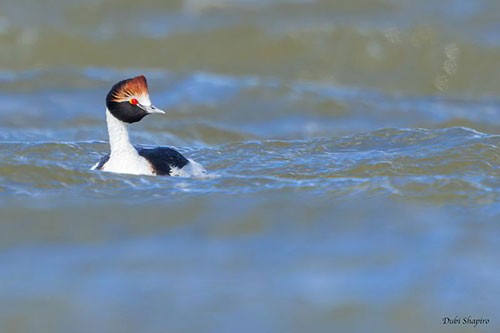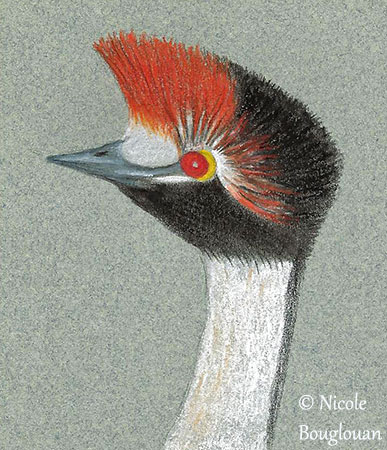
The female lays two white eggs, becoming progressively brownish in the nest. Only one chick hatches after three weeks of incubation. A replacement clutch may occur if the first brood is lost.
The chick has grey down with bold stripes, and the underparts are paler. It is fed by both parents with very small prey, but two weeks later, it is able to feed on snails like the adults.
The reproductive rate is very low and the colonies are closely related to the density of snails.
PROTECTION / THREATS / STATUS:
The Hooded Grebe is threatened by the introduced American Mink that kills both chicks and adults, and also by predation by the Kelp Gull. But introduction of both salmon and trout involve competition for food and modifications of lake conditions by increasing the levels of cyanobacteria (formerly called “blue-green algae”).
Several lakes may completely dry or have seasonally very low water levels, involving more impact from the introduced fish and thus on the grebes.
The strong winds in these areas may lead to the failure of an entire colony, and excessive grazing by sheep causes erosion on the shores, limiting the growth of the emergent vegetation.
At wintering sites, the adults drown in fishing nets.
The global population is roughly estimated to number 650/800 mature individuals and it is now stable, thanks to extensive conservation actions and creation of national park in Patagonia.
However, the Hooded Grebe is currently listed as Critically Endangered.
Fr: Grèbe mitré
Ang: Hooded Grebe
All: Goldscheiteltaucher
Esp: Zampullín Tobiano
Ita: Svasso monaco
Nd: Patagonische Fuut
Sd: kamdopping
Photographer:
Dubi Shapiro
Dubi Shapiro Photo Galleries
Text and illustrations by Nicole Bouglouan
Sources:
HANDBOOK OF THE BIRDS OF THE WORLD vol 1 by Josep del Hoyo-Andrew Elliot-Jordi Sargatal - Lynx Edicions - ISBN: 8487334105
Birds New to Science: Fifty Years of Avian Discoveries De David Brewer – Editeur: Bloomsbury Publishing, 2018 – ISBN: 1472906292, 9781472906298 – 416 pages
Edge of existence – Hooded Grebe
Earth Touch News network - Standing Guard: Saviours of the hooded grebe
Paws Trails Magazine - Hooded Grebe (Podiceps gallardoi)
Aves Argentina - Sympathy for the grebes: Hooded Grebe conservation programme update (2011–2017)
Preventing Extinction of the Hooded Grebe
Conservation of the Hooded Grebe
Wikipedia, the free encyclopaedia
Hooded Grebe
Podiceps gallardoi
Podicipediformes Order - Podicipedidae Family
INTRODUCTION:
The Hooded Grebe is one of the most beautiful species discovered in South America in the 20th century. It was only discovered in 1974. It is found in SW Argentina where it breeds, but it winters in estuaries of the Atlantic coasts of Santa Cruz in Patagonia.
It breeds in volcanic lakes where colonies of up to 130 pairs are established. The floating nest is built on aquatic vegetation. This species is known for the amazing courtship displays during which the birds are “dancing” on water surface.
The Hooded Grebe feeds mainly on small invertebrates, but the chicks are fed on small aquatic insects during the first two weeks. This grebe typically feeds by diving and often in dispersal flocks.
The Hooded Grebe is threatened by the introduced American Mink, but large fish and climate change also affect this species.
The decline of the population has been rapid, but extensive conservation actions allow now to have small but stable population. However, the Hooded Grebe is currently listed as Critically Endangered.

On the head, the forehead is white. On the forecrown, we can see fine, hair-like, erectile, bright orange-rufous feathers. Ear-coverts, lower face and upper throat are black. A unique feature among grebe is the yellow, crescent-shaped wattle behind the eye.
The pointed bill is bluish-grey. The eyes are bright red. The legs are blackish to dark grey but the lobbed feet are mostly dark slaty-blue.
Male and female are similar.
The juvenile has black hood contrasting with the white lower parts of head and nape.
RANGE:
The Hooded Grebe is found mainly in the Patagonian province of Santa Cruz in Argentina where it breeds on inland lakes. It winters at three estuaries, Río Coyle, Río Gallegos and Río Chico estuaries on the Atlantic coast of Santa Cruz.
There are some records in Magallanes, S Chile, and two individuals have been seen on a lake in Laguna Blanca in 2013.
HABITAT:
The Hooded Grebe breeds in very inhospitable habitat, in volcanic upland lakes at 500/1,500 metres of elevation, battered by storms. They are surrounded by cliffs, or at least on one side, acting as shelters. The lakes are fairly deep with clear water, and bordered with fringing reeds. Depending on water level, these lakes may offer more or less floating vegetation on which the grebes build their nests. But these lakes also need areas of open water allowing the grebes to feed.
On migration after the breeding season, the grebes are seen on smaller lagoons with brackish water and some floating vegetation. But they remain in these areas only for short periods.
They spend the winter in estuaries on the Atlantic coast where the brackish water provides them abundant food resources. The rest of the population probably winters near the breeding areas in lakes that do not freeze
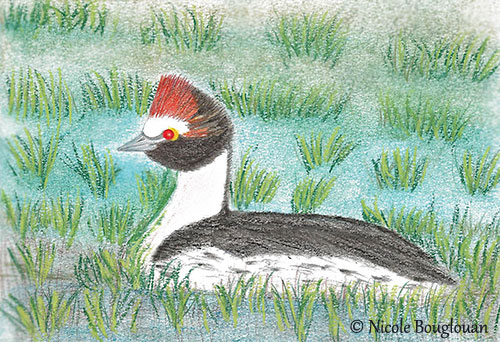
CALLS AND SONGS: SOUNDS BY XENO-CANTO
The Hooded Grebe is very vocal. The main call is a melodious whistle “terr-wheee-err” or “teete-wheee-err”. Mechanical ticking calls are heard during the displays and also a loud “ki-wee, ki-wee” given continuously.
BEHAVIOUR IN THE WILD:
The Hooded Grebe feeds on various small invertebrates such as amphipods and arthropods. But the main food source is the snail Lymnaea diaphana of 8 -15 mm in length.
The young are fed on small prey such as midge pupae, bugs and larvae of water beetles. About two weeks after hatching, they are able to feed on snails too.
The Hooded Grebe feeds mostly by diving during 15-30 seconds, usually some metres from the shore. During winter, the diet is not well known but from a report, a dead grebe had mainly fish (sprat) and spider crabs in the stomach, a small amount of algae and molluscs.
The Hooded Grebe is known for its elaborate and spectacular courtship displays, involving numerous visual displays during the spring. When they are forming the pair bond, they dance with their bodies raised vertically on the water. Numerous pairs are observed during winter continuing the same displays, indicating that the pair bonds continue after the end of the breeding season.
The displays are complex, with several movements and interactions within small groups. These displays include advertising, bouncy dive, head turning from side to side, and head flicking back and forth, preening, wing quivering and others.
Both mates “walk” quickly on the water, stopping sometimes breats to breast while neck and head move rapidly back and forth or turn from side to side.
As the Hooded Grebe is found in Argentina, the dances performed during the displays were very quickly related to a tango. It’s magic!
Like other grebes, this species typically builds a floating nest. They breed in colonies of up to a hundred pairs, established on floating vegetation in volcanic lakes protected by rocky walls.
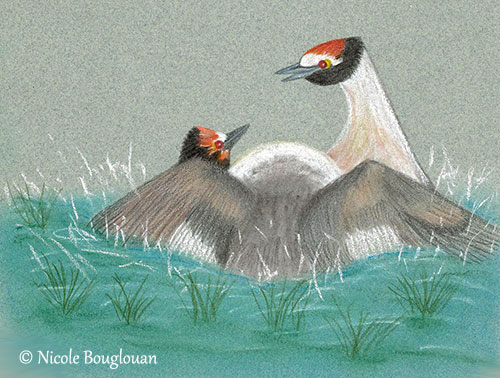
The Hooded Grebe is migratory. Movements occur between lakes during summer, probably at night. They leave the breeding lakes in May, before the water freezes. They spend the winter in estuaries on Atlantic coast, sometimes in fjords and channels in S Chile.
The flight is direct with steady wingbeats.
REPRODUCTION OF THIS SPECIES:
The laying takes place in December/January or February.
The Hooded Grebe is a colonial nester, with 5 to 75, and up to a hundred pairs. The colonies are found in clear, volcanic lakes surrounded, or at least on one side, by cliff walls that provide a shelter from the strong winds in this region of Patagonia.
The nest is built on dense, floating vegetation of Myriophyllum elatinoides. The Hooded Grebe builds a weed platform usually larger than in other grebes, probably adapted to the effects of both wind and waves. It is built on thick, floating carpets of water reeds and anchored to the aquatic vegetation.
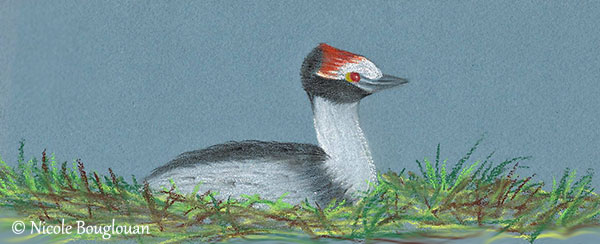
DESCRIPTION OF THE BIRD:
Biometrics:
Length: 32 cm
Weight: 420-610 g
The Hooded Grebe shows black-and-white pattern with strong contrast between white neck and flanks and black head and back.
The upperparts are dark slaty grey. The wings are largely white, but inner and lesser coverts are black, like the tips of the outer primaries. The hindneck shows a thin, vertical, black median stripe.
The underparts are silvery-white with blackish spots on flanks.
